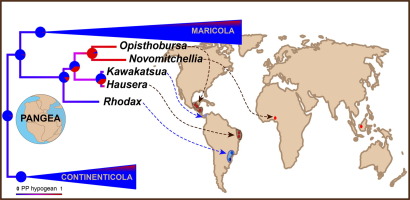当前位置:
X-MOL 学术
›
Mol. Phylogenet. Evol.
›
论文详情
Our official English website, www.x-mol.net, welcomes your feedback! (Note: you will need to create a separate account there.)
Phylogeny and biogeography of the Cavernicola (Platyhelminthes: Tricladida): Relicts of an epigean group sheltering in caves?
Molecular Phylogenetics and Evolution ( IF 4.1 ) Pub Date : 2019-12-17 , DOI: 10.1016/j.ympev.2019.106709 Lisandra Benítez-Álvarez 1 , Ana Maria Leal-Zanchet 2 , Alejandro Oceguera-Figueroa 3 , Rodrigo Lopes Ferreira 4 , Diego de Medeiros Bento 5 , João Braccini 2 , Ronald Sluys 6 , Marta Riutort 1
Molecular Phylogenetics and Evolution ( IF 4.1 ) Pub Date : 2019-12-17 , DOI: 10.1016/j.ympev.2019.106709 Lisandra Benítez-Álvarez 1 , Ana Maria Leal-Zanchet 2 , Alejandro Oceguera-Figueroa 3 , Rodrigo Lopes Ferreira 4 , Diego de Medeiros Bento 5 , João Braccini 2 , Ronald Sluys 6 , Marta Riutort 1
Affiliation

|
The planarian suborder Cavernicola Sluys, 1990 was originally created to house five species of triclad flatworms with special morphological features and a surprisingly discontinuous and broad geographic distribution. These five species could not be accommodated with any degree of certainty in any of the three taxonomic groups existing at that moment, viz., Paludicola Hallez, 1892, Terricola Hallez, 1892, and Maricola Hallez, 1892. The scarce representation of the group and the peculiarities of the morphological features of the species, including several described more recently, have complicated new tests of the monophyly of the Cavernicola, the assessment of its taxonomic status, as well as the resolution of its internal relationships. Here we present the first molecular study including all genera currently known for the group, excepting one. We analysed newly generated 18S and 28S rDNA data for these species, together with a broad representation of other triclad flatworms. The resulting phylogenetic trees supported the monophyly of the Cavernicola, as well as its sister-group relationship to the Maricola. The sister-group relationship to the Maricola and affinities within the Cavernicola falsify the morphology-based phylogeny of the latter that was proposed previously. The relatively high diversity of some cavernicolan genera suggests that the presumed rarity of the group actually may in part be due to a collecting artefact. Ancestral state reconstruction analyses suggest that the ancestral habitat of the group concerned epigean freshwater conditions. Our results point to an evolutionary scenario in which the Cavernicola (a) originated in a freshwater habitat, (b) as the sister clade of the marine triclads, and (c) subsequently radiated and colonized both epigean and hypogean environments. Competition with other planarians, notably members of the Continenticola, or changes in epigean habitat conditions are two possible explanations -still to be tested- for the loss of most epigean diversity of the Cavernicola, which is currently reflected in their highly disjunct distributions.
中文翻译:

Cavernicola的系统发育和生物地理学(Platyhelminthes:Tricladida):躲在洞穴中的Epigean团体的遗迹?
涡虫亚目Cavernicola Sluys,最初创建于1990年,用以容纳五种具有特殊形态特征和出人意料的不连续且广泛的地理分布的三角lad扁虫。当时存在的三个分类学组中的任何一个都无法以任何确定性来容纳这五个物种,即,Paludicola Hallez(1892年),Terricola Hallez(1892年)和Maricola Hallez(1892年)。该物种的形态特征的特殊性(包括最近描述的几种特征)使对Cavernicola单亲属的新测试,其分类地位的评估以及其内部关系的解析变得复杂。在这里,我们提出了第一个分子研究,其中包括该组目前已知的所有属,但其中一个属除外。我们分析了这些物种的新近生成的18S和28S rDNA数据,以及其他三头扁平虫的广泛代表。所形成的系统发育树支持了Cavernicola的单亲性,以及它与Maricola的姐妹群关系。与马里科拉的姐妹群关系以及在鸡笼草中的亲密关系伪造了先前提出的后者的基于形态学的系统发育史。一些穴居人科属的相对较高的多样性表明,该群体的稀有性实际上可能部分归因于收集的人工制品。祖先状态重建分析表明,该群体的祖先栖息地与Epigean淡水状况有关。我们的结果指出了一种进化场景,其中黑洞藻(a)起源于淡水栖息地,(b)作为海洋三足动物的姊妹进化枝,(c)随后辐射并定居于Epigean和Hygegean环境中。与Cavernicola的大部分表皮多样性丧失有关的两种可能的解释(尚待检验)是与其他平面动物的竞争,尤其是Continenticola成员的竞争,或表皮栖息地条件的变化,这目前可能在其高度分离的分布中得到反映。
更新日期:2019-12-18
中文翻译:

Cavernicola的系统发育和生物地理学(Platyhelminthes:Tricladida):躲在洞穴中的Epigean团体的遗迹?
涡虫亚目Cavernicola Sluys,最初创建于1990年,用以容纳五种具有特殊形态特征和出人意料的不连续且广泛的地理分布的三角lad扁虫。当时存在的三个分类学组中的任何一个都无法以任何确定性来容纳这五个物种,即,Paludicola Hallez(1892年),Terricola Hallez(1892年)和Maricola Hallez(1892年)。该物种的形态特征的特殊性(包括最近描述的几种特征)使对Cavernicola单亲属的新测试,其分类地位的评估以及其内部关系的解析变得复杂。在这里,我们提出了第一个分子研究,其中包括该组目前已知的所有属,但其中一个属除外。我们分析了这些物种的新近生成的18S和28S rDNA数据,以及其他三头扁平虫的广泛代表。所形成的系统发育树支持了Cavernicola的单亲性,以及它与Maricola的姐妹群关系。与马里科拉的姐妹群关系以及在鸡笼草中的亲密关系伪造了先前提出的后者的基于形态学的系统发育史。一些穴居人科属的相对较高的多样性表明,该群体的稀有性实际上可能部分归因于收集的人工制品。祖先状态重建分析表明,该群体的祖先栖息地与Epigean淡水状况有关。我们的结果指出了一种进化场景,其中黑洞藻(a)起源于淡水栖息地,(b)作为海洋三足动物的姊妹进化枝,(c)随后辐射并定居于Epigean和Hygegean环境中。与Cavernicola的大部分表皮多样性丧失有关的两种可能的解释(尚待检验)是与其他平面动物的竞争,尤其是Continenticola成员的竞争,或表皮栖息地条件的变化,这目前可能在其高度分离的分布中得到反映。


























 京公网安备 11010802027423号
京公网安备 11010802027423号